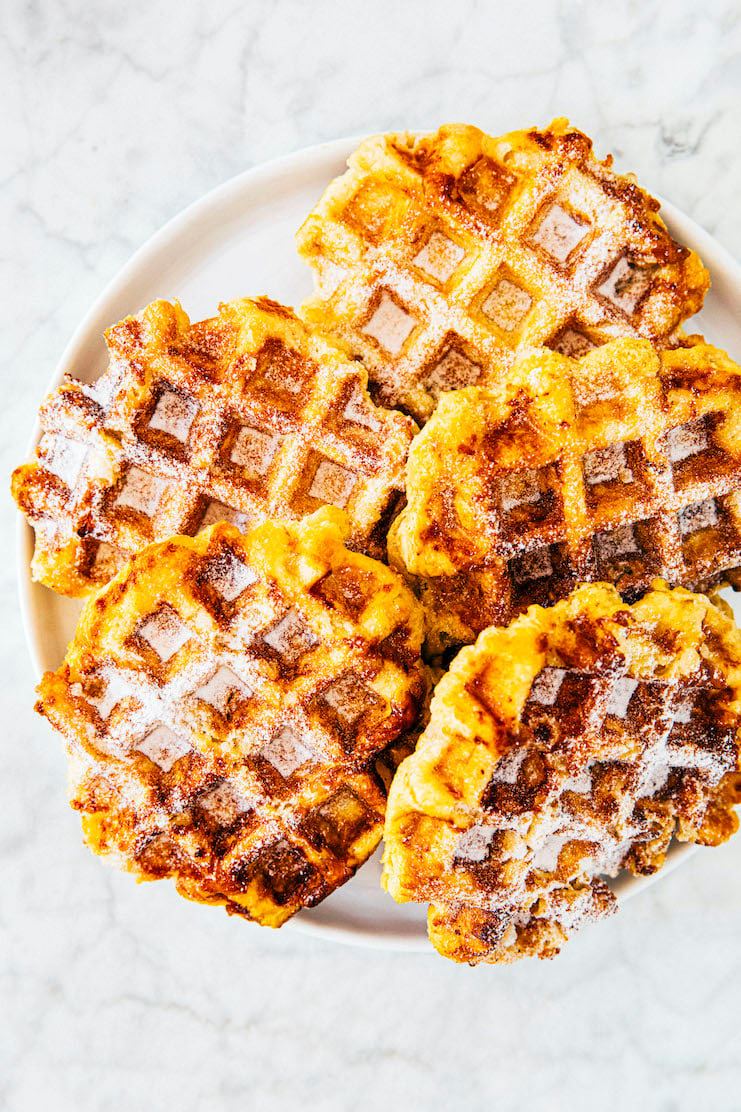
What are Liège Waffles?
In Belgium, there are two types of waffles: the Brussels and the Liège waffle. The Brussels waffle is more commonly known as the “Belgian waffle”. Although Brussels waffles were traditionally made from a yeasted dough, they are now typically made from cake batter. This cake batter uses baking powder or soda as its leavener, resulting in light and crispy waffles. The Brussels waffle is very similar to the Belgian waffles you find on breakfast menus in the United States.
In contrast, Liège waffles are made from a yeasted, brioche dough studded with Belgian pearl sugar. Liège waffles are dense and chewy, with a texture similar to the bread in a freshly toasted panini. The best part? Each Liège waffle is interspersed with giant lumps of Belgian pearl sugar. These are giant, coarse lumps of granulated sugar around the size of chocolate chips. If cooked when buried within the batter, the pearl sugar melts, giving the waffle delicious, molten flavor. BUT if the pearl sugar happens to be on the outside of the waffle batter, the sugar turns crunchy and caramelizes. A bite tastes like a combination of buttery brioche and crème brulée.
Sounds good, right? Well, you’re in luck. They’re incredibly easy to make at home, too!
Why I Love Liège Waffles
But first, if you can spare the time, I want to share the story of why I love Liège waffles:
I graduated from college in 2009, in the middle of one of the worst recessions the world has ever experienced. I took the first (low-paying) job I was offered, and found myself living in expensive San Francisco on a pittance. Here I was, a foodie, living in one of the world’s best cities for restaurants and fine dining, unable to afford any of it! I felt frustrated and stuck.
But I was young and creative. As a result, I lived off the the free weekly newspaper’s annual cheap eats archive. Through this series, I discovered a quaint coffee shop called Star Stream. Inside, you could find a variety of affordable, delicious pastries like popcorn chocolate chip cookies and Liège waffles. The best part? The coffee shop was on my way to work! Soon, it became tradition for me to grab a Liège waffle anytime I needed motivation for a long, hard day of work. Truthfully, it also became tradition to grab a Liège waffle as a pick-me-up after a long, hard day, too (lol).
After I’d moved away, I was heartbroken when I saw on Yelp that Star Stream had gone out of business. Those waffles brought me a lot of joy and comfort during a difficult time. So years later, when I was writing my cookbook Weeknight Baking (which tells the story of how I started this blog as an escape from my corporate job), I knew I had to include a Liège waffles recipe.
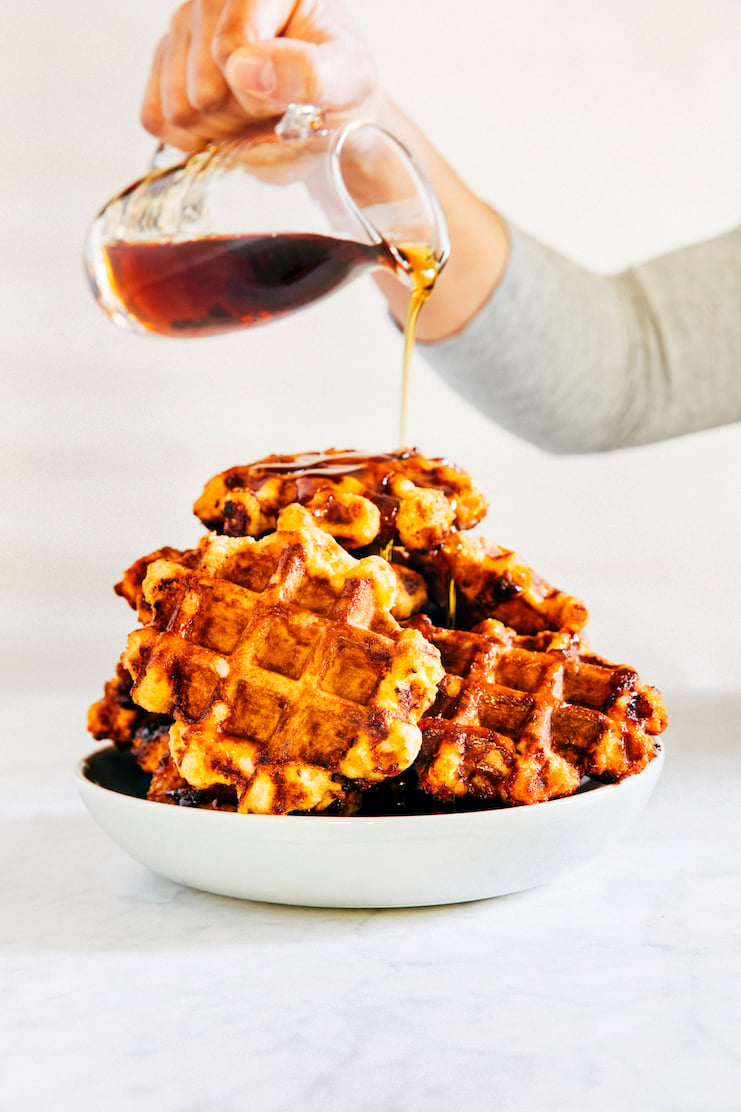
A Note About The Liège Waffles Recipe In My Cookbook
The Liège waffles recipe below is from my cookbook, Weeknight Baking. However, the recipe contains a misprint. Specifically, after making the Liège waffles dough, the recipe instructs you to turn the dough out onto the kitchen counter and knead it into a ball. The recipe then instructs you to proof the dough overnight.
But Liège waffle dough actually has a texture and consistency more similar to batter than dough. So if you own a copy of my cookbook, I recommend ignoring that instruction and following the recipe below instead. Although you can technically follow the book’s instructions, it’s messy and inconsistent. You’ll need to add a LOT of flour in order to knead the dough. You get much better results if you simply let the dough proof overnight without kneading it. The Liège waffle dough will turn into a more traditional, knead-able dough after an overnight proof in the fridge.
I sincerely apologize to anybody who followed the recipe’s instructions and were either confused or disheartened by the results. I hope to fix this misprint in the next edition of my book.
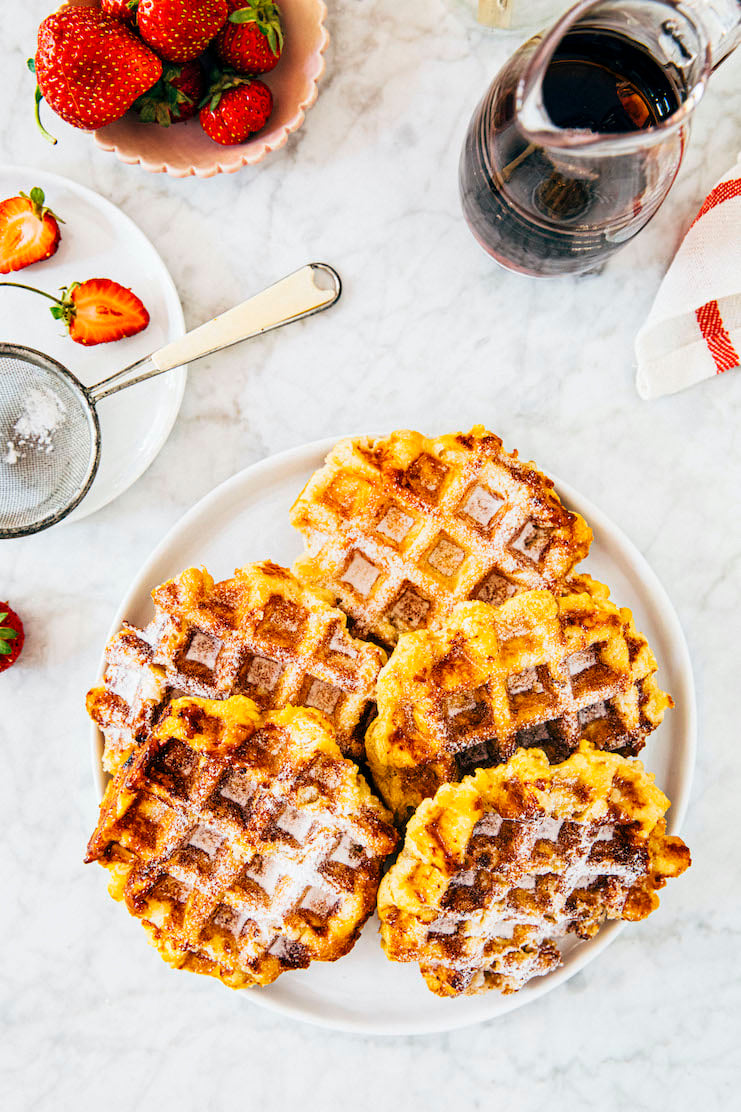
Liège Waffles Ingredients and Substitutions
Now that I’ve convinced you to make Liège waffles, here’s your shopping list for the recipe:
Liège Waffles Recipe Shopping List
- all-purpose flour
- dark OR light brown sugar
- instant yeast
- kosher salt
- large eggs
- unsalted butter
- pure vanilla extract
- Belgian pearl sugar
And let’s talk about some of its key ingredients and their substitutions:
Brown Sugar
The Liège waffles recipe recipe uses 1 ½ Tablespoons brown sugar to make the waffle dough.
Light versus Dark Brown Sugar
Brown sugar is granulated white sugar with a touch of molasses to give it its signature color and flavor. Because brown sugar contains molasses, it adds more moisture baked goods than granulated sugar otherwise would. Brown sugar is available in two varieties: light or dark. Dark brown sugar is my personal preference; because it contains more molasses, I find it to be more flavorful. However, you can use either in this liège waffles recipe without altering its flavor too much.
Instant Yeast
This Liège waffles recipe uses 1 ¾ teaspoons instant yeast to make the waffle dough.
What’s the difference between active dry yeast and instant yeast?
Good question! I highly encourage you to check out this article on The Kitchn explaining the difference between the two. In general, I prefer to use instant yeast in my recipes. Why? You get to skip a step, and it generally proofs faster than active dry yeast!
Can you use active dry yeast instead of instant yeast in this liège waffles recipe?
Yes, but you will need to change the way you activate the yeast and mix it into the dough.
First of all, active dry yeast and instant yeast are activated at different temperatures. In general, recipes instruct you to activate active dry yeast with ingredients that are heated to between 110° and 115°F, and instant yeast with ingredients that are heated to between 120° and 130°F.
Second, in addition to these different activation temperatures, active dry yeast and instant yeast need to be activated in different ways. Bakers activate active dry yeast by soaking it in warm water with a little bit of sugar. Instant yeast, on the other hand, can be added directly to dry ingredients (like you would baking powder or baking soda) without needing to be soaked beforehand.
So, if you’re planning on using active dry yeast in this recipe, add it directly to the warm water and let sit for 5 minutes or until foamy and emitting a distinct yeasty flavor. Then, pour it into the dry ingredients and follow the recipe’s directions for adding the eggs, butter, and vanilla extract.
Belgian Pearl Sugar
This Liège waffles recipe uses 1 cup Belgian pearl sugar to make the waffle dough.
What is Belgian pearl sugar?
Belgian pearl sugar is the signature ingredient of Liège waffles. The pearl sugar looks like small, white pebbles (but made out of sugar instead of stone, obviously). I’ve also seen other folks describe Belgian pearl sugar as similar to crushed, irregular sugar cubes. Either way, these pearl sugar pebbles melt and caramelize in the waffle dough, giving Liège waffles their molten appearance and signature crunch.
Wait, is Belgian pearl sugar the same thing as Swedish pearl sugar?
NO! Belgian pearl sugar looks like pebbles. However, Swedish pearl sugar is much smaller—it looks more like pretzel salt! Using Swedish pearl sugar in this Liège waffles recipe (or any Liège waffle recipe, really) will NOT produce the right results.
Okay, so where do you buy Belgian pearl sugar?
Back when I first posted this recipe, you could only get Belgian pearl sugar online at Amazon, and occasionally at fancy grocery stores like Whole Foods Market and specialty cooking shops like Sur La Table. However, in the last few years, I’ve seen Belgian pearl sugar sold at QFC, Walmart and online grocery shopping services like Instacart. Pretty cool, right?
What Belgian pearl sugar brands do you recommend?
Again, back in 2013, when I first posted this recipe, there was only one brand of Belgian pearl sugar readily available in the United States: Lars’ Own Belgian Pearl Sugar. I relied on this brand for many years and used it to make my Liège waffles.
However, when I needed to develop the Liège waffles recipe in Weeknight Baking, it quickly became too expensive to buy multiple small boxes of Lars’ Own Belgian pearl sugar. I ended up buying this bulk bag of pearl sugar from The Belgian Kitchen on Amazon instead. It looked and tasted exactly the same as Lars’ Own.
That being said, there are now many options to choose from on Amazon. Pick whatever fits your budget. There’s no need to splurge, it will all taste the same—delicious.
Can you make Belgian pearl sugar at home?
Yes, with reservations. A quick Google search tells me that there are many recipes available online for homemade Belgian pearl sugar. Baker Bettie instructs you to make your own Belgian pearl sugar by crushing sugar cubes with a hammer. My friend Erika at The Pancake Princess tells you to boil sugar and water down to form sugar clumps similar to Belgian pearl sugar. However, because I haven’t tried either method, I can’t personally recommend either. So if you try one of these methods to make my Liège waffles recipe, let me know in the comments! I want to hear how it turned out.
Can you substitute Belgian pearl sugar with something else in this Liège waffle recipe?
No, please don’t. Like I said before—Belgian pearl sugar is the signature ingredient of Liège waffles. Without it, you’ll just be making regular ol’ yeasted Belgian waffles.
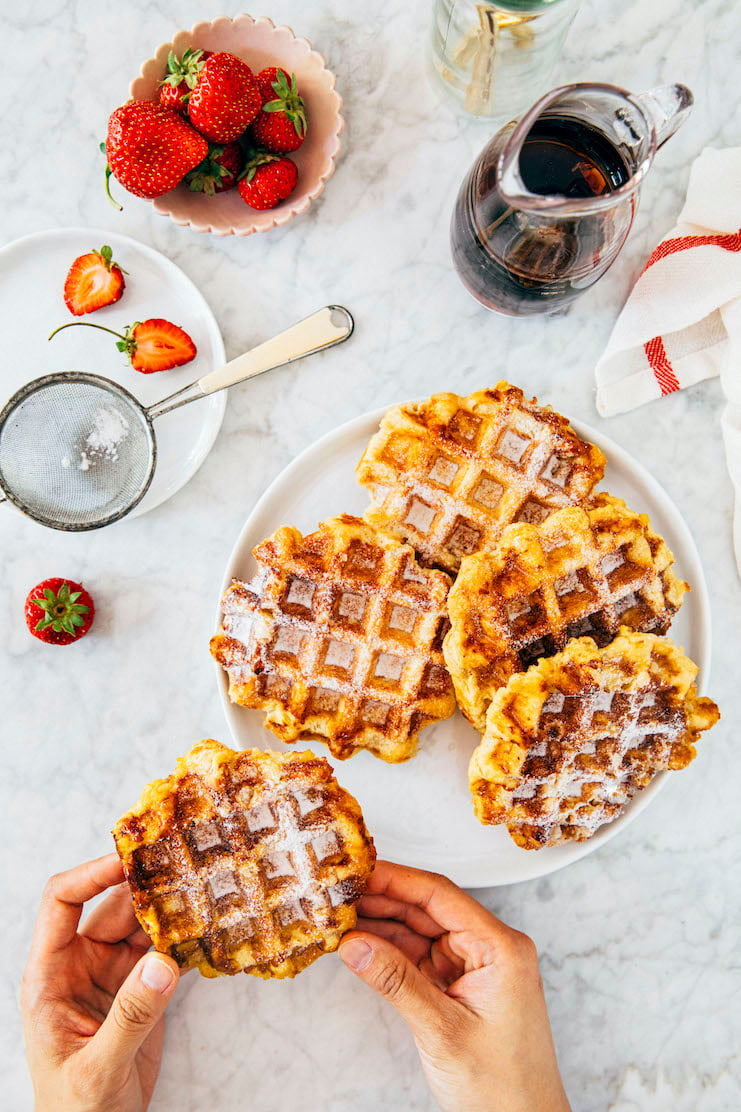
How To Make Liège Waffles
Here are the basic steps to make Liège waffles from scratch:
First, make the waffle dough.
- Prep the ingredients to make the Liège waffle dough. (Prep Time: 10 minutes)
For this recipe, it’s important that all the ingredients are at the temperature listed in the recipe. Why? First of all, remember that yeast is a living thing. If you activate the yeast at a temperature that’s too warm, you might accidentally kill the yeast and end up with a dough that doesn’t rise. However, on the flip side, the yeast won’t activate if other ingredients—like the water, eggs, and buttermilk—are too cold. So, to really set yourself up for success, take the extra 5 minutes to make sure all the ingredients are measured out and are at the right temperatures! - Make the Liège waffle dough. (Work Time: 5 minutes)
After you’ve prepped the ingredients, making the waffle dough itself is a breeze. First, mix together the dry ingredients in a stand mixer. Add the water, eggs, butter, and vanilla and mix for 5 minutes until sticky and thick. That’s it! - Proof the Liège waffle dough. (Rise Time: Overnight)
Once the dough is ready, cover the bowl with plastic wrap and stick it in the refrigerator. The fridge’s cooler temperature enables the dough to rise at a slower pace than it otherwise would at room temperature. The next morning, you end up with a perfectly risen dough that’s perfect for Liège waffles!
The next day, finish making the dough and cook the waffles.
- Preheat the oven and waffle iron. (Prep Time: 5 minutes)
You don’t technically need to bake the waffles in the oven. But if you’re baking the waffles in a big batch to serve all at once, I recommend turning the oven on to a low heat. Place the waffles in the oven to keep them warm as you cook the rest of the dough. - Mix the Belgian pearl sugar into the waffle dough. (Work Time: <5 minutes)
While the oven and waffle iron preheats, mix the Belgian pearl sugar into the dough with a stiff rubber spatula. There’s no need to be precious about it—at this point, the Liège waffle dough should have the texture of a more traditional yeasted dough and can take a good beating! - Cook the waffles. (Cook Time: 5 minutes* per waffle)
Follow your manufacturer’s instructions to divide the dough into waffles and cook until crisp and golden brown. The recipe yield and overall Bake Time will vary depending on your waffle iron’s capacity per press. I averaged around 4 to 5 minutes per press for golden brown waffles.
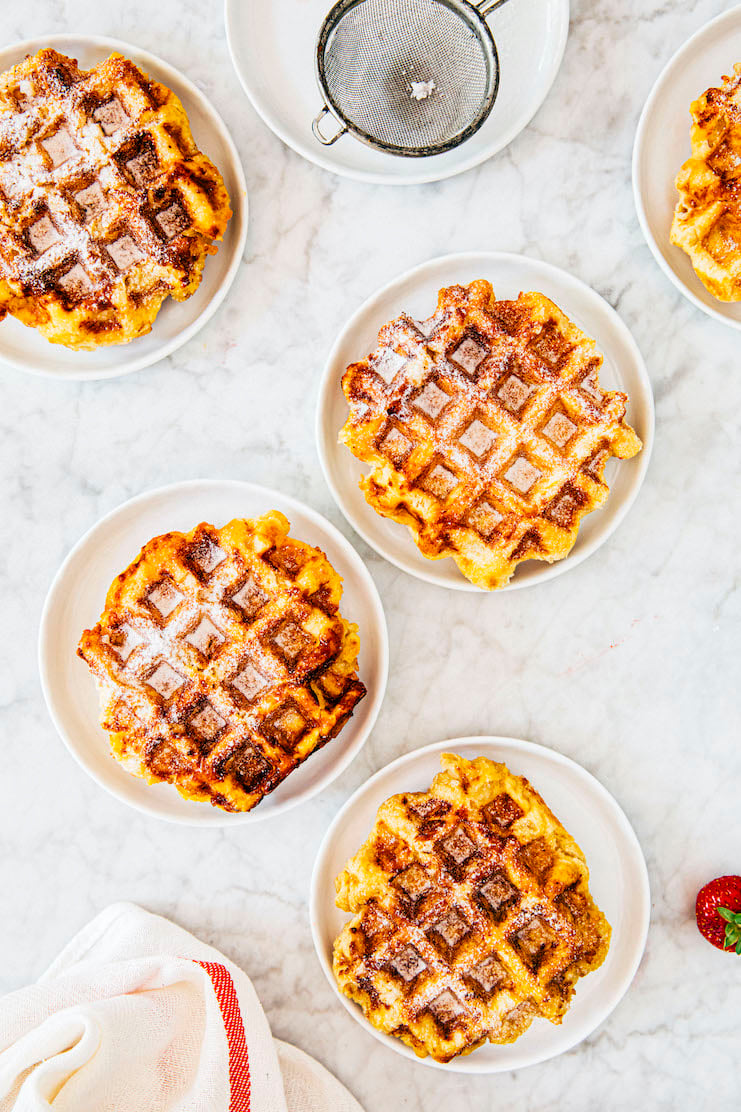
Liège Waffles Recipe Troubleshooting and FAQ
FAQ: Best Tools for Making Liège Waffles
Do you have a waffle iron recommendation?
Yes! To make my Liège waffles, I used this Breville Smart Pro 2 Slice Waffle Maker. It’s a Belgian-style waffle maker with a wide range of settings to allow you to adjust texture and browness levels. I especially like the LCD-display that has a countdown of when your waffles will be done!
That being said, the Breville waffle maker is on the spendy side. If I were on a budget, I’d probably opt for this Krups Belgian waffle maker. According to this round-up of waffle makers by The Wirecutter, the Krups model has REMOVABLE plates! That means you can remove the waffle mold from the machine and either hand wash or dish wash them. Pretty cool, right?
Wait, what’s the difference between a Belgian-style waffle maker and a regular waffle maker?
A regular waffle maker makes thin waffles with relatively shallow cavities. These cavities are typically around ½ inch deep. On the other hand, Belgian-style waffle makers have deeper molds that are around 1 ½ inches deep. As a result, Belgian-style waffle irons and makers result in thicker, denser waffles.
Do I need a Belgian-style waffle maker to make Liège waffles?
If you’re looking for an authentic Liège waffle experience, yes, you absolutely do. However, in a pinch, you can make this recipe in a regular waffle maker, too. The texture will be slightly off since your waffles will come out much thinner than mine. But I honestly think they’ll still be tasty.
FAQ: Liège Waffles Recipe Techniques
Help! My dough came out super thin. It looks more like brownie or pancake batter than brioche dough. What did I do wrong?
Absolutely nothing! When developing the Liège waffle recipe for my cookbook, Weeknight Baking, I made six different Liège waffle recipes and taste-tested them side-by-side. One was a traditional Belgian recipe from an old European cookbook; the other was the Liège waffle recipe in the Lars Own Belgian pearl sugar package. Others were gleaned from more modern cookbooks and trusted food blogs and magazines. But all had one thing in common: the recipes made a thin, batter-like dough. Based on my research (short of actually heading to Liège and spying on famed waffle makers), I think this is what traditional Liège waffle dough is like!
And don’t worry! The dough firms up as it cools. After about an hour or so at room temperature, it will start to look and feel more like a sticky brioche dough. The effect is magnified the longer it sits. In the recipe below, I instruct you to refrigerate the dough and let it rise overnight. In the morning, you’ll be greeted with a dough that looks and feels more like traditional brioche dough. You’ll be able to pick it up, roll it into a ball, and knead the Belgian pearl sugar by hand then.
Do I really have to proof the dough for these Liège waffles overnight? Or can I make this Liege waffle recipe all in one day instead?
If you insist, you technically can make the Liège waffles all in one day. After making the dough, instead of refrigerating, let sit in a warm spot until doubled in size, about 1 to 2 hours. Then, follow the recipe’s instructions for mixing in the Belgian pearl sugar and cooking the waffles.
That being said, I don’t recommend making the Liège waffles all in one day. Why? Between you and me, Liège waffle dough can be finnicky. If it’s a super hot day, the butter has a tendency to separate from the dough. And regardless of the day’s temperature, the dough will be harder to measure and scoop into the waffle iron. It will be too sticky and gloopy without the overnight chill in the fridge.
Additionally, the overnight rise in the fridge allows the dough to develop the complex, yeasty flavors you know and love from bread. It’s worth it, I promise.
Can I add other mix-ins besides Belgian pearl sugar to these Liège waffles?
You technically can, but I don’t recommend it. Most folks who read my blog are inclined to add chocolate chips to their waffles (hey—I see you and respect you!). However, these Liège waffles are plenty sweet already with just the Belgian pearl sugar. If you add chocolate chips, your waffles will turn out too sweet!
Additionally, in Belgium, Liège waffles are often served unadorned with no toppings or syrups. They come in three simple flavor variations: plain, vanilla (the recipe below is technically a vanilla Liège waffle), and cinnamon (add ¾ teaspoon ground cinnamon to the dough if that’s your jam). If you want an authentic experience, I encourage you to keep your Liège waffles simple!
What do you serve with Liège waffles?
Like I said above, in Belgium, Liège waffles are typically served plain with no toppings. No fruit, maple syrup, and/or whipped cream. Once you have a bite, you’ll understand why—Liège waffles are enough of a treat by themselves!
That being said, I’ve seen Liège waffle vendors—Wafels and Dinges in New York City, The Waffle Window in my hometown of Portland, Oregon—serve Liège waffles in the style of Brussels waffles. That is, you can order Liège waffles topped with traditional Brussels waffles toppings like fruit, Nutella, syrup, and more. I once had a Liège waffle topped with bananas, Nutella, and whipped cream. While it was delicious, I was definitely in a sugar coma for the rest of the WEEK.
TL/DR? You do you. If you want to top your Liège waffles with toppings, go for it! But don’t say I didn’t warn you.
FAQ: How To Store Liège Waffles
How To Store Liège Waffles
Liège waffles are best served warm and fresh from the waffle iron. However, they can store well, too. After cooking, cool the waffles on a wire rack completely. The waffles can be stored in an airtight container or zip-top bag at room temperature for up to 1 day. After that, follow the instructions below to freeze any leftover waffles. Serve at room temperature, or toast in a traditional toaster or toaster oven like you would frozen Eggo waffles!
Can you refrigerate Liège waffle dough?
Yes! This recipe actually instructs you to refrigerate the Liège waffle dough overnight. Why? Doing so helps thicken the Liège waffle batter to a more traditional bread dough texture. It also gives the waffles a unique, distinct yeasty flavor that you get from good artisan bread and brioches.
Can you freeze Liège waffles?
Yes! In fact, cooked Liège waffles freeze beautifully. Place any leftover waffles in a large zip-top bag and freeze for up to 3 months. To serve, toast in a traditional toaster or toaster oven—there’s no need to let the waffles thaw beforehand! However, you may need to toast them for longer than you would room-temperature bread.
Best Liège Waffle Recipe Tips
Best Ingredient Tips
- The Liège waffle dough requires 1 ½ Tablespoons of brown sugar. Unfortunately, a 1 ½-Tablespoon measure isn’t typically available with most measuring spoon sets. However, you can use a ½-teaspoon and 1-teaspoon measure to measure out the equivalent of 1 ½ Tablespoons. Specifically, 1 ½ Tablespoons equals 4 ½ teaspoons. You can also buy a 1 ½ Tablespoon measure on Amazon. Learn more in my Best Small Batch Baking Tools guide!
- Pay attention to the ingredients and the temperatures they’re listed at in the recipe. Yeast is a living thing and you can easily kill it by mixing it with water and butter that’s too hot. You want the temperature of these ingredients to be similar to that of a warm bath and no more. And be sure to use eggs that are at room temperature rather than straight from the fridge! Eggs straight from the fridge will be too cold and will lower the temperature of the overall mixture, risking dropping it to a point where the yeast won’t activate properly.
Best Equipment Tip
- The recipe below also instructs you to make the Liège waffle dough in a stand mixer fitted with the paddle attachment. Traditionally, yeasted recipes instruct bakers to use the dough hook attachment. However, because Liège waffle dough is thin like a batter, I recommend using the paddle attachment instead.
Best Portioning Tip
- The yield of this recipe will vary based on how much dough it will take to make a single waffle in your waffle iron. I mentioned earlier that I used this Breville Smart Pro 2 Slice Waffle Maker. It takes a whopping ½ cup of batter/dough to make a single waffle! However, in Weeknight Baking, I used a 4-Tablespoon cookie dough scoop to make 12 waffles with this recipe. This time around, I used 8 Tablespoons of waffle dough (scooped with 2 portions from the 4-Tablespoon cookie dough scoop) to make 6 thicker waffles.
Best Cooking Tip
- When making the first batch of waffles, I lightly coat my waffle press with cooking spray. However, these Liège waffles don’t really need it. They are so buttery that they leech a lot of butter out into the press as they cook, making them self-greasing (lol). So don’t worry if you see that happening—it’s totally normal, I promise!
Video Tutorial for Liège Waffles Recipe
Use the video player below to watch my Instagram Story tutorial on how to make this liège waffle recipe! The arrows to the left and right of the frame allow you to skip through the different recipe steps. You can also hit the “pause” or “enlarge” buttons on the upper right hand side of the frame to pause or enlarge the frames accordingly.
Alternatively, head to my Instagram profile to watch these Stories on mobile! The circles underneath my bio indicate saved Instagram Story highlights depicting various recipes. Clicking on one of the circles will play the videos you see above. You may need to scroll right to find this liège waffle recipe.
More Waffle Recipes
- Apple Cider Waffles
- Chaffle Recipe
- Chicken and Waffles Recipe
- Overnight Eggnog Waffles
- Paleo Banana Bread Waffles
More Yeasted Breakfast Pastry Recipes
- Black Tahini Morning Buns
- Buttermilk Cinnamon Rolls with Cream Cheese Glaze
- Caramel Apple Sticky Buns
- Chocolate Babka Morning Buns
- Cookies and Cream Morning Buns
- Maple Bacon Cinnamon Rolls
- Overnight Black Sesame Buttermilk Rolls With Goat Milk Glaze
- Overnight Ube Cinnamon Rolls
- Quick Whole Wheat Cinnamon Rolls
- Small Batch Cinnamon Rolls
- Small Batch Pecan Sticky Buns
- The Biggest Sticky Bun In The World
Other Traditional Breakfast Recipes: French Toast, Pancakes, and More
- Banana Bread French Toast
- Brown Butter Crêpes
- Cinnamon French Toast Crunch
- Mini Chocolate Chip Pancake Layer Cake
- Mini Pancake Cereal Recipe
- Overnight Babka French Toast
- Overnight Pumpkin French Toast
- Pain Perdu
- Silver Dollar Crêpes
Get the Recipe: Liège Waffles Recipe
Ingredients
For the Liège Waffles:
- 2 cups (9 ounces or 255 grams) all-purpose flour
- 1 ½ Tablespoons tightly packed dark OR light brown sugar
- 1 ¾ teaspoons instant yeast
- ¾ teaspoon kosher salt
- ⅓ cup (2.65 ounces or 75 grams) water, warmed to between 120° and 130°F
- 3 large eggs, at room temperature
- 1 cup (8 ounces or 227 grams) unsalted butter, melted and warmed to between 120° and 130°F
- 1 teaspoon pure vanilla extract
- 1 cup (5.5 ounces or 156 grams) Belgian pearl sugar
Equipment
- a waffle iron
Instructions
Day 1: Make the Dough
- First, make the waffle dough. In the bowl of a stand mixer fitted with the paddle attachment, combine the flour, brown sugar, yeast, and salt. Beat on low until just combined. Slowly pour in the water and beat until a shaggy dough forms, about 1 minute. Add the eggs, one at a time, adding the next egg only after the previous one has been fully incorporated, using a rubber spatula to scrape down the bottom and sides of the bowl after each addition. With the mixer on low, slowly pour in the melted butter and vanilla and beat for 1 minute, then increase the mixer to medium and beat for 2 to 3 minutes more, or until no more butter is pooling at the bottom of the bowl. The dough will be sticky, thick, and a little lumpy. It will look more like pancake batter at this point, but that's totally okay, I promise!
- Refrigerate overnight. Cover the bowl with plastic wrap. Refrigerate overnight.
Day 2: Make the Waffles
- Prep your oven and waffle iron. Preheat the oven to 250°F. Preheat a waffle iron according to the manufacturers' instructions and lightly coat each waffle plate with cooking spray.
- Uncover the dough and discard the plastic wrap. Use a rubber spatula to mix in the pearl sugar.
- Cook the waffles. Divide the dough and cook the waffles according to the manufacturer's instructions until crisp and golden brown, coating the waffle plates with cooking spray between batches as needed.
- Serve and store. Serve immediately, or place the finished waffles directly on the oven rack to keep them warm and crisp until ready to serve.

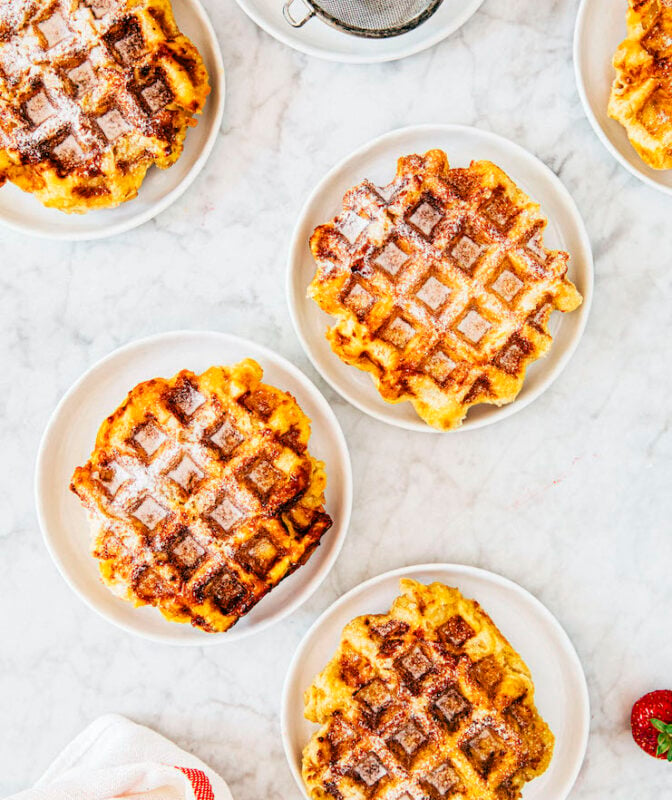
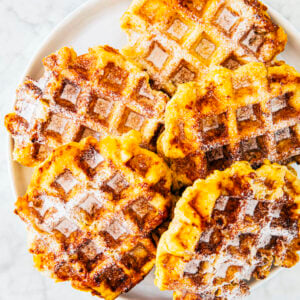


These look like the best breakfast ever! I wonder if they'd be good if you cool them and dip them in chocolate for dessert 🙂 yum.
Your description has my mouth watering! I've never had a Liege waffle, but I'm pinning this recipe to try. Thanks for sharing!
Oh dear those look amazing. I'm making waffles tomorrow for breakfast… but, lord knows I don't have the patience to wait for two hours to have them rise properly. That one is going to have to wait for a special occasion… or maybe breakfast as dinner!
Liege waffles are one of my absolute faves – there's nothing better than those crunchy bites of sugar and the buttery rich dough. I definitely need to buy a waffle maker…
These waffles look wonderful!!!
These look absolutely amazing. I love waffles…I need to make these on a Saturday morning sometime as a special treat.
xxx
Jaclyn
http://www.loveandbellinis.com
would the rock sugar (rock salt size granules) from Wilton's work? It is probably the same cost, but it can be found at JoAnns.
Rock sugar from Wilton would work, but it won't be as authentic as the liege waffles. Instead, I recommend using sugar cubes, giving them a quick grind in a food processor (or, if you don't have a food processor, stick them in a zip lock bag and use a rolling pin to give them a few good whacks) to break them up.
This looks amaaaazing! 🙂
http://cafecraftea.blogspot.com
I did everything as you suggested, right down to the pear sugar (thank you Amazon!) and these were so delicious we couldn’t stand it. My most favorite waffle ever! Thank you!
I made a batch of these liege waffles the second you posted the recipe and they turned out perfect. I didn’t proof over night, but 6 hours in the fridge worked for me. Crisp buttery waffles with an amazing crunch, courtesy of the pearl sugar. I wish I doubled this recipe as I only have a few to freeze for later. Thank you for a wonderful recipe!
So I’m making these now. I use an All Clad waffle maker. It’s nonstick and has never had recipes stick to my. How do I clean off all this melted sugar? I hope I didn’t just destroy my waffle iron!
Hi! Don’t panic—the next time you make a batch of waffles, you can use a “sacrificial” waffle and cook it in the iron without cleaning it. Once the waffle finishes cooking and you lift out the waffle, it should take all the gunk with it.
If you want to be more proactive, heat up the waffle iron (it’s easier to clean while it’s hot, but be SUPER careful). Once it’s hot, turn it off and wipe it down with a paper towel. To get the paper towel between the crevices/cavities, you can use a fork or a chopstick and kind of wipe it down that way. That’ll help prevent you from burning yourself!
I just made these for breakfast. Made the dough last night and put it in the fridge, like instructed. To tell you the truth I was very sceptical, but boy oh boy, the turn out great! So crispy on the outside and layered on the inside, kinda like croissant. I don’t know how am I going to eat other waffles from now on.
Thank you very much ❤️!
The waffles are delicious, I always used another recipe sent by my Belgian friend, but decided to search for a better one.
There are pools of butter that drip from my waffle iron, when I flip my iron and in my waffle iron, am I doing something wrong?
Hi Michelle, thank you so much for such a wonderful blog and book. In the book you say to tip out the dough in a lightly floured counter but the dough is super runny, I did it but had to add like half a cup of flour to the batter, so my question is we should just leave it in the bowl? And not tip it out? Thank you!
Hi! Great question—I actually talk about it in this blog post, but the recipe in my book has a typo. This is the correct version! And here’s the note about it:
“A Note About The Liège Waffles Recipe In My Cookbook
The Liège waffles recipe below is from my cookbook, Weeknight Baking. However, the recipe contains a misprint. Specifically, after making the Liège waffles dough, the recipe instructs you to turn the dough out onto the kitchen counter and knead it into a ball. The recipe then instructs you to proof the dough overnight.
But Liège waffle dough actually has a texture and consistency more similar to batter than dough. So if you own a copy of my cookbook, I recommend ignoring that instruction and following the recipe below instead. Although you can technically follow the book’s instructions, it’s messy and inconsistent. You’ll need to add a LOT of flour in order to knead the dough. You get much better results if you simply let the dough proof overnight without kneading it. The Liège waffle dough will turn into a more traditional, knead-able dough after an overnight proof in the fridge.
I sincerely apologize to anybody who followed the recipe’s instructions and were either confused or disheartened by the results. I hope to fix this misprint in the next edition of my book.”
To my knowledge, the Breville waffle iron makes American style waffles. Have you tried these in a Belgium style iron? If so any significant difference?
Disclaimer I’ve never been to Belgium and had Liège waffles there but these were delicious!! Super simple to come together and not too heavy or too sweet. I have a “NordicWare Belgian waffler” which you use on the stove so it’s easy to control the temperature and done-ness. These came out perfect. Definitely a recipe I’d make again.